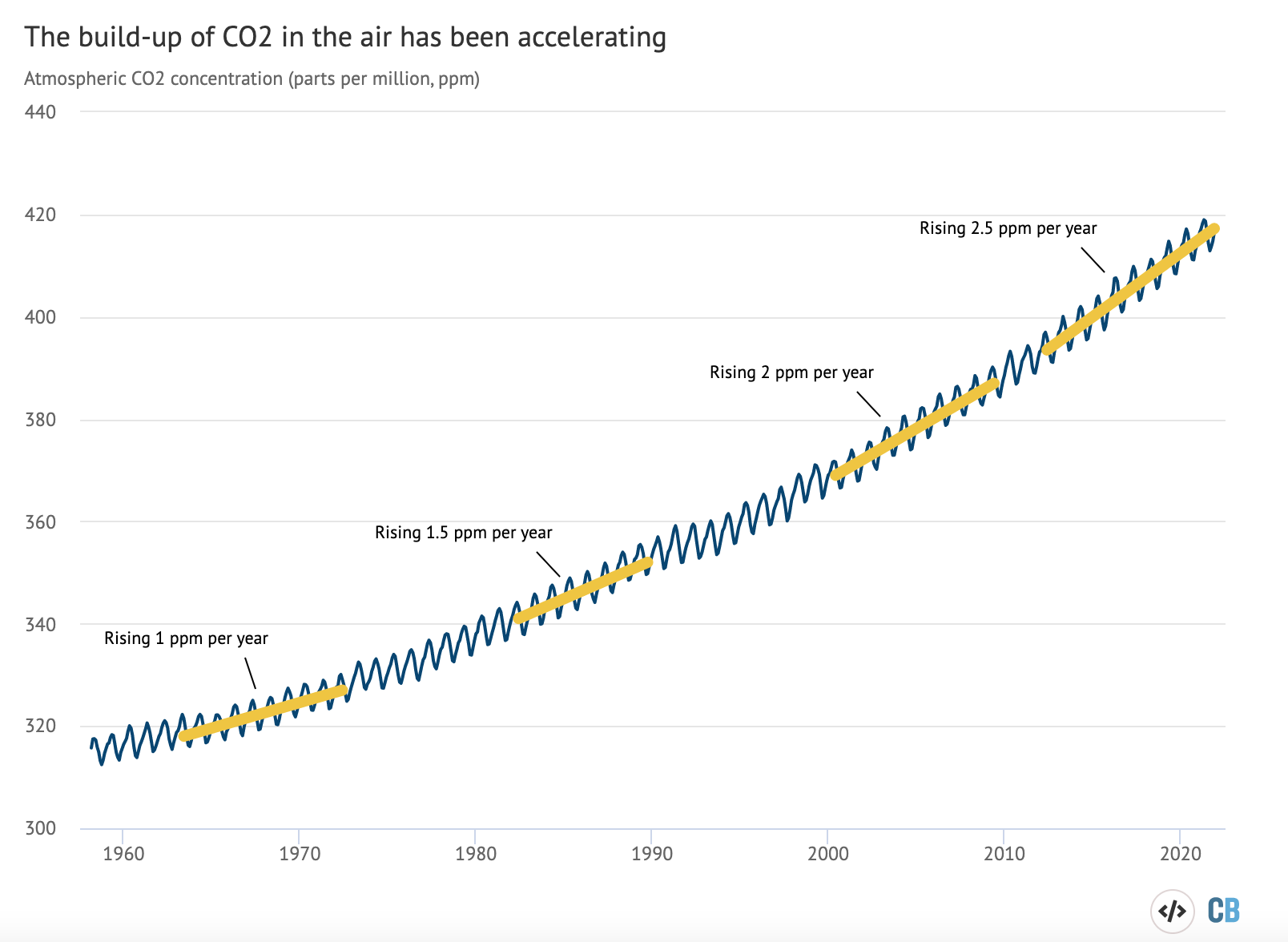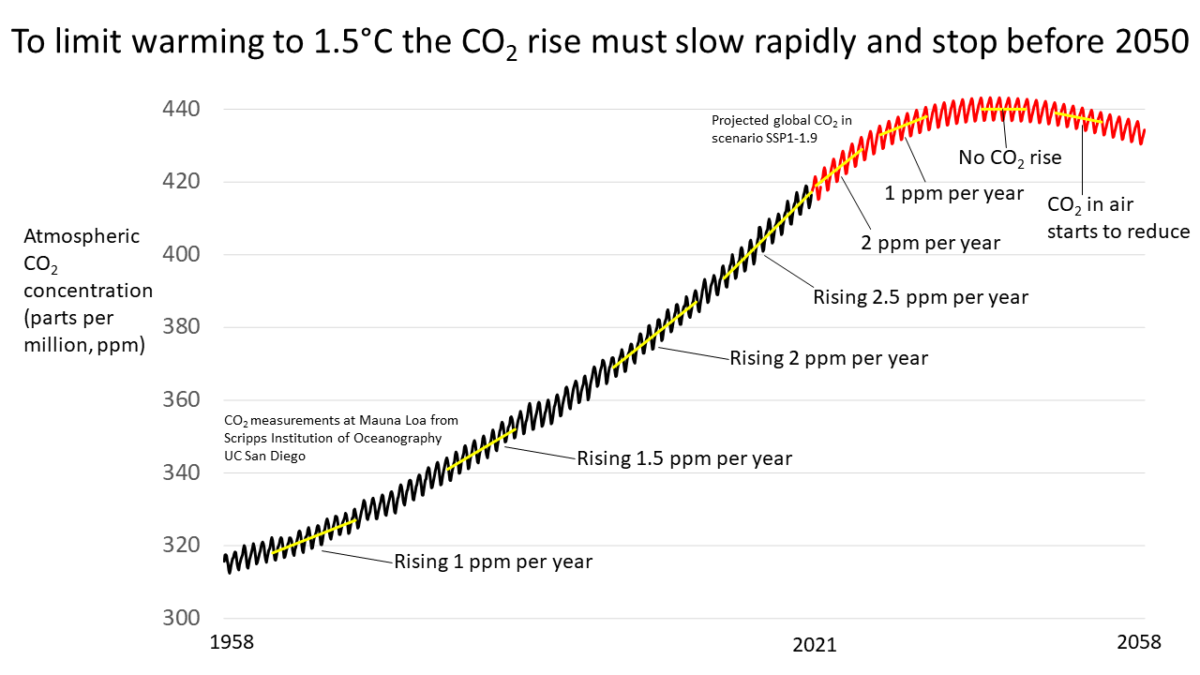If any single illustration best highlights our climate predicament, it is probably the Keeling Curve. Now scientists are warning that time is running out to reverse its steep upward trend.
Named after Dr. Charles David Keeling, the atmospheric scientist who began measuring CO2 in the air atop Mauna Loa volcano in Hawaii way back in 1958, the iconic Keeling Curve graph shows an accelerating upwards saw-tooth curve as human emissions of carbon dioxide accumulate relentlessly in our atmosphere.
There was no slow-down in CO2 rises after the Earth Summit in 1992, nor with the Copenhagen meeting in 2009 nor even with the much-heralded Paris Agreement of 2015. As far as the Keeling Curve is concerned, humans have so far achieved more or less nothing in the battle to stabilize the Earth’s climate.
Indeed, if anything, the slope of the curve is getting steeper, showing an acceleration in the rate at which anthropogenic CO2 is accumulating. When Charles Keeling first installed his infrared gas analyzer on the summit of Mauna Loa in 1958, the CO2 concentration in the air he found was about 316 parts per million (ppm) and was subsequently found to be rising at a rate of just under 1ppm per year.
By the 1980s this rise had reached 1.5ppm per year and accelerated further to 2ppm per year by the first decade of the 21st century. In the last 10 years — even as the world increasingly woke up to the climate emergency — the rate accelerated still further to 2.5ppm per year, with the average atmospheric CO2 concentration reaching 416ppm in 2021.

So, is the 1.5 Paris goal now out of reach? Not quite, according to the United Kingdom Met Office, which issued its annual CO2 forecast today. However, to meet the 1.5C goal humans will have to do something they have never achieved since the Industrial Revolution began — bend the Keeling Curve down.
Specifically, the Met Office states that atmospheric increases in CO2 must slow to 2ppm over the next five-year period, and halt completely by the early 2040s. For this to happen, human emissions must of course fall rapidly from now onwards, reaching net zero by the middle of the century and becoming negative after that.

Even this incredibly ambitious pathway — referred to as the “SSP1-1.9 scenario” in the latest generation of climate models — would still see global warming overshoot 1.5 degrees Celsius by the middle of the century, although the temperature would then drop back below this level by 2100.
The rate of CO2 rise isn’t exactly the same each year. Although human emissions can fluctuate a bit — falling during the first two years of the COVID pandemic, for example, due to reduced economic activity — a bigger factor is natural cycles like the El Niño-Southern Oscillation (ENSO) phenomenon in the tropical Pacific, which modulates the rate at which oceans and land ecosystems absorb some of the additional atmospheric CO2.
For example, the largest CO2 rise on record took place between 2015 and 2016, when a strong El Niño event caused heatwaves and droughts across the tropics, sparking devastating wildfires and reducing carbon absorption from forests. In 2021, the opposite occurred, with mild La Niña conditions increasing land uptake of carbon.
With a “double-dip” La Niña in the cards this year, the Met Office forecasts that CO2 levels will rise by 2.14 ± 0.52 ppm in 2022, a slightly smaller increase than the average of 2.45ppm over the last 10 years.
The good news is that this reduction in CO2 accumulation puts us nearly on track for the 1.5-degree scenario. The bad news is that it is only a temporary reprieve, courtesy of the natural biosphere, and that once the ENSO cycle shifts back into a warm phase the Met Office expects the rate of CO2 rise to return close to 2.5ppm per year — unless of course human emissions are cut drastically in the meantime.
So, what’s the upshot? In a guest post on CarbonBrief, Met Office scientists led by Prof. Richard Betts, writing together with Prof. Ralph Keeling — Dr. Charles Keeling’s son, who has continued his father’s CO2 monitoring program at the Scripps Institution of Oceanography in California — offer some insights.
They admit that “while there is growing skepticism around whether the 1.5C target is politically feasible, at the moment it can be argued — from the perspective of the Earth System at least — that it is still physically possible to ‘keep 1.5C alive’.” The authors add that climate models suggest warming will stop almost immediately when total emissions reach net zero.
But they end with a somber warning: “However, if the rate of rise of atmospheric CO2 does not begin to slow markedly within the next few years, the chances of limiting global warming to 1.5C will rapidly vanish.”
As some of the participants of last year’s COP26 meeting in Glasgow pointed out, the 1.5-degree goal is not yet dead, but it is on life support. Meeting it will require bending the Keeling Curve downwards, a so-far impossible challenge that needs to be met within as little as the next five years.
Image: Mauna Loa observatory. Photo: Christopher Michel/Flickr
